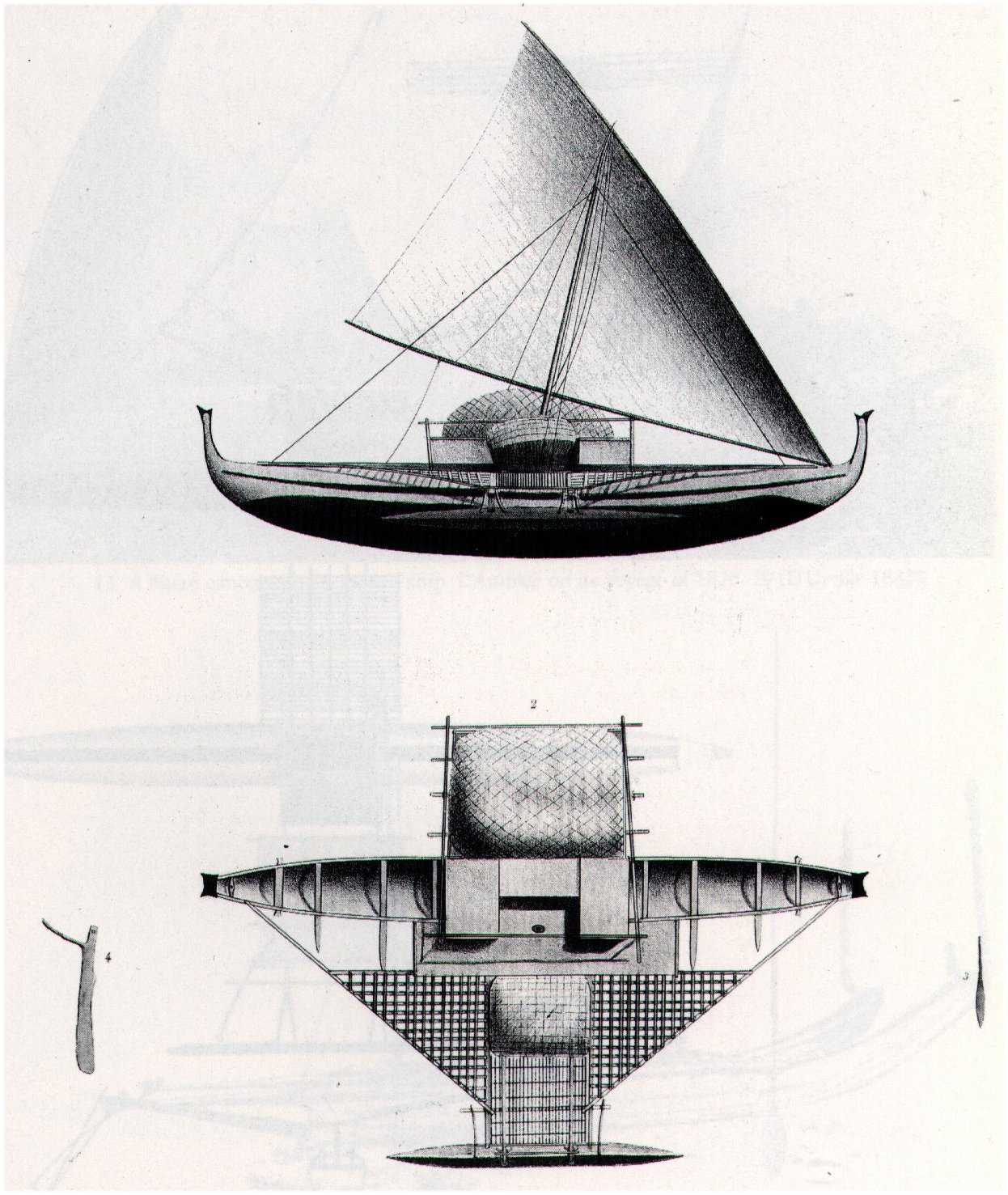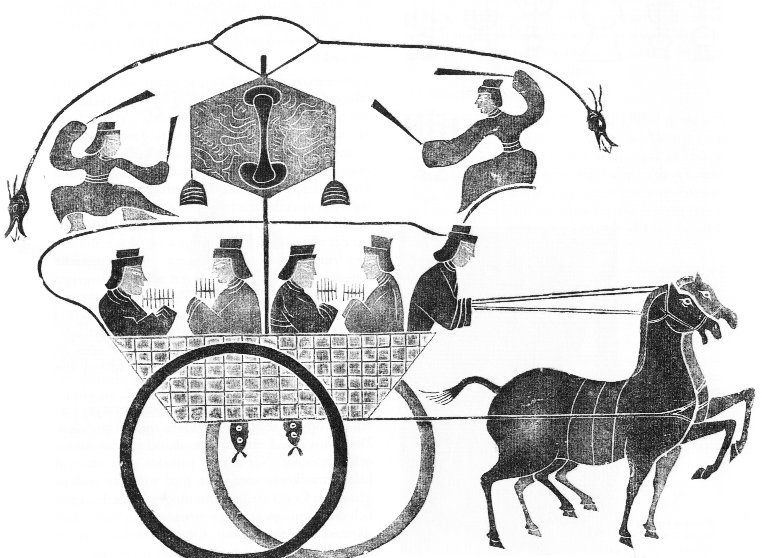|
TRANSLATIONS
This is the 4th period. In Pa5-43 we can see that now the sun has grown in power and that he is yet advancing in strength by taking in more light, in Pa5-44 there is a complex glyph with its major component showing a clear henua - at last there is no longer any trace of the shadows of the preceding night. Pa5-45 gives us evidence of two hours. The little black dot at right in the middle is presumably a mark incised in the wood before the glyphs were written, a mark to make it easier to determine where the glyphs should be located. Such a dot can be seen in Pa5-44 too. The 4th period is completed with tapa mea, the glyph for the end of a period of light. In Pa5-43 the central disc is somewhat larger than that in Pa5-39, the 'top flame' has grown, and the flame hanging down like an arm at left is longer:
However, the bent arm is not as powerful, meaning that the increase is no longer proceeding as fast as in the 3rd period. The bent arm ending in a hand with three fingers (meaning 'fire') is also a sign for the boat of the sun. Most clearly this is seen in Pa5-39. The vessel which brings the sun up from the underworld and into this world of ours has an adornment in front (rei mua) and also an adornment at its end (rei muri). Here rei mua is the hand of fire, while rei muri has the form of haga (showing a change of state: the end of the boat).
(Canoe from the Caroline Islands, Irwin) Pa5-44 has in the foreground henua. Whereas double henua - as e.g. in Pa5-45 - signifies a period of time divided into two parts, the single henua has a meaning of domain, here the 'kingdom' of light. The 'central kingdoms' glyph in China
has been used there since about 680 B.C. and is derived from the picture of a staff with a drum hanging in the middle, both signifying ruling power. Like in the picture below from the oldest remaining building in China (Hall of Ancestors, Feicheng).
(Information and pictures from Lindqvist) The rongorongo glyph henua is derived from the picture of a wooden staff and the implied meaning is similar: order (as created - of necessity - by a dominating ruler with a big stick in his hand). In Pa5-44 disorder is quenched under the straight and beautifully proportioned rectangular form of henua, while disorder (here: night) is illustrated by the irregular winding shape underneath henua. Pa5-45 is quite similar to Pa5-37:
Altogether we therefore have 4 'staffs' (henua) of this kind. As the solar year is divided into quarters (sorted into two per half-year) so the solar day must be. In Pa5-41 we can discern a 5th thinner 'staff'. The 'author' of rongorong-text P might here be alluding to the additional 5-day-period needed to complete the 4 * 90 = 360 days of the official year to reach the real year with 365 days. These additional 5 days are outside the domain of the solar force and they are therefore 'black' = disorderly, which is seen in the 6 hatch-marks at right. Pa5-37 would then correspond to the half-year from summer solstice to winter solstice and Pa5-45 to the half-year between winter solstice and summer solstice. Quite in order as the 5th period (noon) then will correspond to summer solstice. Pa5-37 and Pa5-45 presumably also may indicate that the sky is being uplifted from the earth by means of these 'tree-trunks' in order to let in the light. Polynesian myth informs us that in the beginning sky and earth were in close embrace. Note the drummers with four drumsticks (above the five persons inside the Chinese painting from the Hall of Ancestors). Pa5-46 is quite similar to Pa5-38:
Together they have 2 * 7 = 14 marks towards right, i.e. an allusion to the idea of fortnight. There are 26 fortnights in a solar year, which covers 26 * 14 = 364 days, 4 too many compared with the ordered 360 days. These four may therefore be located one in each quarter as extracalendrical days (giving us 13 weeks - 13 * 7 = 91 - for each quarter), and then we need one more at the time of winter solstice (when one year 'dies' and another is 'born'). Alternatively we place them symmetrically around the year, i.e. insert one after every 72 regular days (5 * 73 = 365). We can imagine those 5 extracalendrical days as 'pillars' holding up the solar sky, like an umbrella with five spokes. On the other hand, seen from a solar perspective we need those 5 days as the gestation period of the new sun and therefore they should be located in between the regular 360-day years. A fortnight is patterned after the period of the moon. For the period of the moon is 29.5 nights which makes it necessary to count two at a time (reaching 59 nights). One of these two periods must then have 29 and the other 30 nights, creating the pattern 29, 30, 29, 30, 29 ... There is an extra night every even month. Two fortnights give us 28 nights, but we should - according to the pattern just established - add one to reach the series 14, 15, 14, 15, 14 ... Each other fortnight an extra night is added, each other month an extra night is added. If we regard weeks, then it will be necessary to add one extra day every 4th week. That is exactly the pattern for the years: every 4th year we need an extra day (because a true year is about 365.25 days). Weeks are connected with solar years, fortnights with lunar months. The seven marks towards right in Pa5-46 and Pa5-38 are unequal in length. Those two in the middle are longer than the others. That presumably alludes to the idea that in the middle of a solar year the sun is stronger (as he is at the middle of the day). Each one of these two glyphs then represents the whole solar year, in the shape of a canoe as seen from above, the solar ship. The vertical straight line in Pa5-42 obviously represents the middle between two solar years, that is the consequence of the interpretation given for Pa5-41 above. In Pa5-34 we see an inversion of the pattern in Pa5-38 and Pa5-46: the middle marks towards right are shorter than the others; night is the inverse of day. If we add these 9 marks with 7 (representing the day) we reach 16 which then represents the double period of night and day. For a total yearly circle 4 * 365 + 1 = 1461 days, there are 4 * 360 = 1440 regular days and 21 'black' (irregular) ones (= 3 such weeks), and 16 * 90 = 1440 (= 16 quarters in four years). We add 5 'dark' days each year and reach 20, then need an additional 'dark' day every 4th year. |




